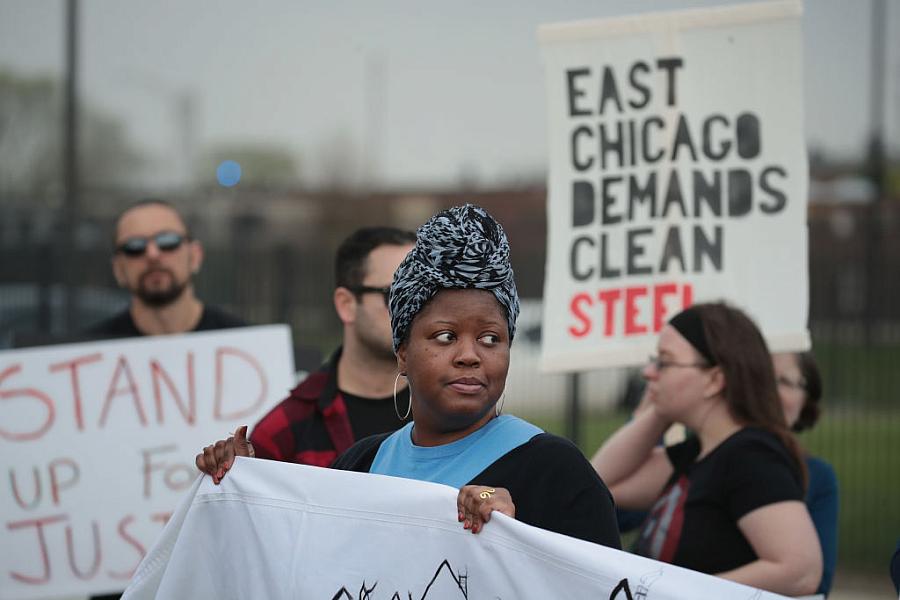The federal infrastructure bill promises transformative investments in environmental justice

Environmental activists protest outside an East Chicago, Indiana elementary school closed in 2016 after high levels of lead and arsenic were found.
(Photo by Scott Olson/Getty Images)
(This post is the third in a series examining the potential health effects of the newly passed infrastructure bill. Read the first two posts here and here.)
Bradley Angel can’t remember the last time he talked to so many reporters in a given week.
For more than two decades, he’s been executive director of Greenaction for Health and Environmental Justice, a San Francisco-based nonprofit that works to protect vulnerable populations from toxic pollutants. In Angel’s eyes, the sudden boost in media attention to a problem he’s dedicated his life to may signal that our country is finally ready to confront the undue environmental harm borne by low-income people and communities of color.
“We're hearing something we've never heard before, which is strong messaging coming from the White House, and the U.S. EPA (Environmental Protection Agency) that environmental justice is actually a priority,” he said. “I think we're gonna see a lot more coverage of this whole issue. How it will play out, we'll just have to see.”
The $1.2 trillion infrastructure bill recently signed into law by President Biden includes investments to protect poor, Black and Indigenous communities from environmental degradation. For instance, the law seeks to reduce traffic congestion and improve air quality, lessen the health impacts of abandoned oil wells, and make the country more resilient to increased flooding, storms, droughts and other disasters related to climate change.
Research has found that environmental injustices lead to asthma, lung cancer, diabetes, obesity and a variety of mental health and development problems.
While the new legislation has sparked media interest in the disproportionate environmental hazards in marginalized communities, following the money will take time and resources that many news outlets don’t have.
“I wish I thought we would be tracking such things,” Al Tompkins, senior faculty member at Poynter Institute, told me. “I imagine a very few will.”
But watchdog reporters have a rich opportunity to see if the United States corrects a wrong perpetrated on communities of color and low-income people for decades.
Environmental justice can’t be untangled from systemic racism in a country that once permitted “redlining,” noted Chandra Taylor, a senior attorney with the Southern Environmental Law Center in North Carolina. That discriminatory practice forced many Black families to live in more undesirable neighborhoods, near smokestacks from polluting factories, next to highways where vehicles spewed toxic emissions, and in low-lying areas prone to flooding.
“There's a lot of aspirational language in the press statements about what this bill can do,” Taylor said. “And certainly the amount of investment has the potential to be transformative. What we'll have to see is how the money gets to where it's going.”
She said she’ll also be watching to see if the White House follows through on its “Justice40” initiative, which promises to direct at least 40% of federal clean energy and climate funding to disadvantaged communities — and whether states follow suit. The administration says it plans to post an annual Environmental Justice Scorecard online beginning next February to detail how it is meeting that pledge.
Taylor suggested some data tools for reporters: the EPA’s environmental justice screening and mapping tool (EJSCREEN); the National Priorities List of hazardous waste Superfund sites; and the Agency for Toxic Substances and Disease Registry.
She also recommended that journalists check out her group’s Broken Ground podcast; the work of environmental investigative reporter Lisa Sorg with NC Policy Watch. News outlets in agricultural states might look into confined animal feeding operations as an environmental justice reporting topic.
Angel, of Greenaction, advised California journalists to check out CalEnviroScreen, a state data source that maps environmental health disparities. “It's the government's own data, and we use that all the time to throw it back at them and say, ‘You even admit that this is a problem,’” he said. The state Department of Toxic Substances Control has a hazardous waste contamination database called EnviroStor.
He said he greatly admired the San Francisco Chronicle’s coverage of the city and county’s redevelopment of the former naval shipyard and Superfund site at Hunter’s Point into a residential community. He said the newspaper’s “bombshell” exposés helped uncover fraud among local government officials and federal contractors as they tried to move the project forward amid uncertainties about its safety. The Chronicle also revealed how a police station was allowed to operate on the site, despite the known hazards.
“Greenaction spends more time fighting our government than fighting industry, which is a curious reality,” Angel noted.
He said High Country News has also done solid reporting about a Native American tribe that’s pushing back against a Utah uranium mill it says is contaminating groundwater with radioactive waste. He spoke to me by phone from southern Utah, where he was on site to help.
Reporters interested in exploring how environmental justice plays out in their communities can also check out recent high-impact projects supported by Center for Health Journalism, including a 2021 Oaklandside series on families suffering respiratory problems from living amid mold, pests and toxic dust, and near air-polluting industry; a 2021 investigation by APM Reports and The Intercept of how the government often fails to protect residents of public housing projects near Superfund sites from environmental hazards; a 2021 Memphis Commercial Appeal project analyzing the health impacts of air pollution on Black residents fighting to stop an oil pipeline in their community; and a 2020 Radio Bilingue story on government delays in cleaning up a lead-contaminated neighborhood in East Los Angeles.
**

